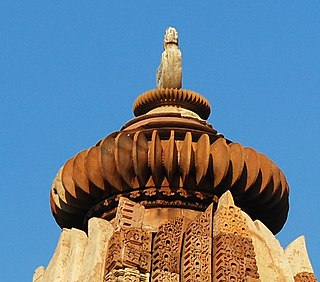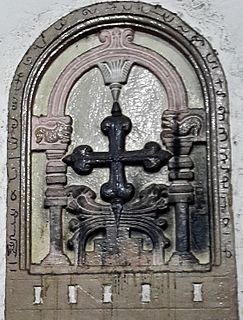 W
WAn amalaka, is a segmented or notched stone disk, usually with ridges on the rim, that sits on the top of a Hindu temple's shikhara or main tower. According to one interpretation, the amalaka represents a lotus, and thus the symbolic seat for the deity below. Another interpretation is that it symbolizes the sun, and is thus the gateway to the heavenly world.
 W
WThe Cellular Jail, also known as Kālā Pānī, was a colonial prison in the Andaman and Nicobar Islands, India. The prison was used by the British for the express purpose of exiling political prisoners to the remote archipelago. Many notable independence activists, including Batukeshwar Dutt, Yogendra Shukla, and Vinayak Savarkar were imprisoned here during the struggle for India's independence. Today, the complex serves as a national memorial monument.
 W
WChhatri are elevated, dome-shaped pavilions used as an element in Indian architecture. The word literally means "canopy" or "umbrella." In the context of architecture, the word is used to refer to two different things. The usual and more widely understood meaning is of a memorial, usually very ornate, built over the site where the funeral (cremation) of an important personage was performed. Such memorials usually consist of a platform girded by a set of ornate pillars which hold up a stone canopy.
 W
WSaint Thomas Christian crosses are ancient crosses that belonged to the ancient community of Saint Thomas Christians of India, who trace their origins to the evangelistic activity of St Thomas the Apostle in the 1st century. It is thus one of the oldest Christian communities of the world. Saint Thomas Christian crosses are broadly classified as Mar Thoma Sleeva, Indian Cross, Persian Cross, and Nasrani Sthambam.
 W
WA deula is an element in a Hindu temple in the local style of Odisha temple in Eastern India.
 W
WAn equestrian statue of Mark Cubbon was unveiled at Bangalore, India on 16 March 1866. The statue is by Carlo Marochetti and was, eventually, placed within the premises of the Karnataka High Court but was moved to Cubbon Park, officially Sri Chamarajendra Park, in June 2020 to improve security around the High Court.
 W
WThe Garden of Silence is a meditative space at the end of Sukhna Lake, Chandigarh, India at 30° 44' 18.60" N 76° 49' 46.80" E. It features a seated Buddha. The garden is financed by the Ministry of Tourism, Government of India, and developed by Chandigarh Administration. This is the latest monument in Chandigarh.
 W
WA hero stone is a memorial commemorating the honorable death of a hero in battle. Erected between the 6th century BC and the 18th century AD, hero stones are found all over India. They often carry inscriptions displaying a variety of adornments, including bas relief panels, frieze, and figures on carved stone. Usually they are in the form of a stone monument and may have an inscription at the bottom with a narrative of the battle. The Earliest and oldest of such memorial Hero stones is found in the Indian state of Tamil Nadu is more than 2400 years old that is 4th Century BC. According to the historian Upinder Singh, the largest concentration of such memorial stones is found in the Indian state of Karnataka. About two thousand six hundred and fifty hero stones, the earliest in Karnataka is dated to the 5th century AD. The custom of erecting memorial stones dates back to the Iron Age though a vast majority were erected between the 4th century BC to 13th centuries AD.
 W
WThe INA Martyrs' Memorial complex is a war memorial at Moirang, India, dedicated to the soldiers of the Indian National Army. The main feature of the complex is a reconstruction of the INA's memorial to its fallen soldiers as it stood in Singapore, before its destruction at the hands of British-Indian Army sappers in 1945. The complex also contains a museum dedicated to the INA along with a library and an auditorium and a statue of Subhas Chandra Bose. Work on the cenotaph itself began in October 1968 and was completed in September 1969, when it was unveiled by Indira Gandhi. Work on expanding the monument complex to present-day size was completed in 2005, when it was unveiled. The total cost in building the memorial was Rs 6.23 crores. A stone monument has also been erected at the historic Moirang Kangla, where Colonel S. A. Malik leading an INA unit raised the flag of Azad Hind in April 1944. The Imphal state government has administered the site since 1985. Close to the complex is the peace memorial at Lotpaching, raised by the Japanese government.
 W
WThe Kos Minars are medieval Indian milestones along the Grand Trunk Road in northern Indian subcontinent, that were introduced by the 16th-century Pashtun ruler Sher Shah Suri. Kos Minars were erected to serve as markers of distance along royal routes from Agra to Ajmer, Agra to Lahore, and from Agra to Mandu in the south.
 W
WThis is a list of places visited by the first guru of Sikhs, Guru Nanak.
 W
WA maidam is a tumulus of the royalty and aristocracy of the medieval Ahom Kingdom (1228-1826) in Assam, India. The royal maidams are found exclusively at Charaideo, near Sibasagar; whereas other maidams are found scattered in the region between Jorhat and Dibrugarh towns. Structurally, a maidam consists of vaults with one or more chambers. The vaults have a domical superstructure that is covered by a hemispherical earthen mound that rises high above the ground with an open pavilion at the peak called chow chali. An octagonal dwarf wall encloses the entire maidam.
 W
WMizo Hlakungpui Mual is a monument to commemorate Mizo poets. It was set up in 1986 at the southern edge of Khawbung Village, Mizoram state, North-East India, about 100 miles northwest of Chittagong, Bangladesh.
 W
WThe Mullivaikkal Memorial or Mullivaikkal Muttram is a memorial dedicated to the Tamils. The Sri Lankan army massacred the Tamils during the final phase of the war between Tamil Eelam freedom fighters (LTTE) and Sri Lankan armed forces at Mullivaikkal in 2009. The Mullivaikal memorial is in the Thanjavur District of the Tamil Nadu State of the Indian sub-continent. On 6th November 2013, the inauguration of The Mullivaikal memorial took place.[2] The Tamil nationalist leader Pazha Nedumaran and the World Tamil Confederation Trust he heads is the founder.[3]
 W
WThe Rang Ghar , is a two-storeyed building which once served as the royal sports-pavilion where Ahom kings and nobles were spectators at games like buffalo fights and other sports at Rupahi Pathar - particularly during the Rongali Bihu festival in the Ahom capital of Rangpur.
 W
WIn Hindu temple architecture, ratha is a facet or vertical offset projection on the plan of the sanctum and shikhara above, or other structure. The term has the same meaning when applied to the forms of the bases of statues.
 W
WSamādhi or samadhi mandir is the Hindi name for a temple, shrine or memorial commemorating the dead, which may or may not contain the body of the deceased. Samadhi sites are often built in this way to honor people regarded as saints or gurus in Hindu religious traditions, wherein such souls are said to have passed into mahāsamādhi, or were already in samādhi at the time of death.